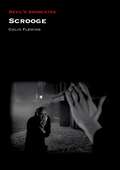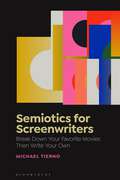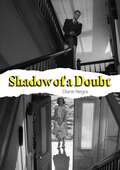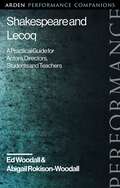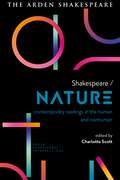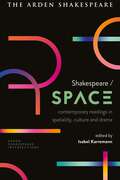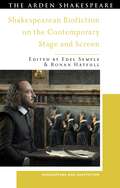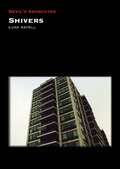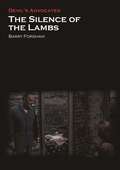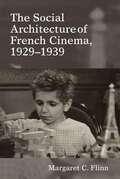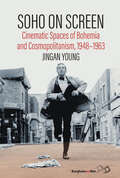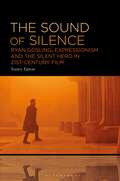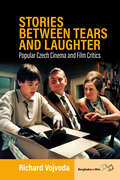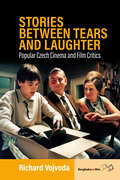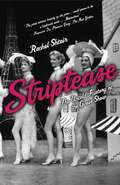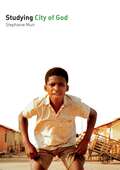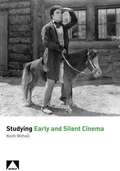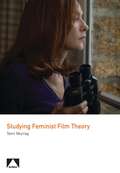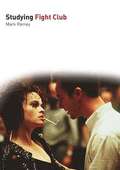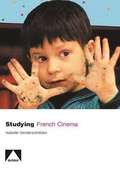- Table View
- List View
Scrooge (Devil's Advocates)
by Colin FlemingThis Devil’s Advocate explores the cinematic wonders of Brian Desmond Hurst’s much loved 1951 adaptation of A Christmas Carol, Scrooge, through the prism of horror cinema, arguing that the film has less in common with cosy festive tradition than it does with terror cinema like James Whale’s Bride of Frankenstein, Robert Weine’s The Cabinet of Dr. Caligari, and F.W. Murnau’s Faust. Beginning with Charles Dickens himself, a prolific writer of ghost stories, with A Christmas Carol being but one of many, Colin Fleming then considers earlier cinematic adaptations including 1935’s folk-horror-like Scrooge, before offering a full account of the Hurst/Sim version, stressing what must always be kept at the forefront of our minds: this is a ghost story.
Semiotics for Screenwriters: Break Down Your Favorite Movies Then Write Your Own
by Michael TiernoYou're trying to finish a screenplay, but there's a voice in your ear whispering, “You should know more about how cinema story works.” Perhaps you've heard how many successful screenwriters deconstruct or “break down” films and study them. You'd like to try this method but ask yourself, “How do I start?” Semiotics for Screenwriters can help you with this daunting task by taking you on a unique journey through 3 classic films - It's a Wonderful Life, Lost in Translation, and Get Out - that shows you the hidden universal language of plot, character, and theme at work in them. This method will reveal the mechanics of cinema story, then show you how to apply this knowledge to your own screenwriting. Semiotics is a powerful system of analysis applied in many fields, including literature and psychology. In this book you'll learn to deploy this method to break down classic films then apply it to writing, developing and correcting your own screenplays.
Shadow of a Doubt
by Diane NegraShadow of a Doubt (1943) was British-born Alfred Hitchcock’s sixth American film and the one that he at various times identified as his favourite and his best. It seems likely that one of the reasons he liked Shadow so much is that is an extraordinarily well-ordered narrative system, a meticulous cause and effect chain that melds its various scenes and sequences together to form a unified narrative that is highly effective in building suspense and cultivating identification with characters. This scrupulously organized film operates as a masterclass on principles of narrative design while generating resonant commentary on the nature of family life. This book redresses the deficit of sustained critical attention paid to Shadow even in the large corpus of Hitchcock scholarship. Analysing the film’s narrative system, issues of genre, authorship, social history, homesickness and ‘family values’, Diane Negra shows how the film’s impeccable narrative structure is wedded to radical ideological content, linking the film’s terrors to the punishing effects of looking beyond conventional family and gender roles. This book understands Shadow as an unconventionally female-centred Hitchcock text and a milestone film that marks the director’s emergent engagement with the pathologies of violence in American life and opens a window into the placement of femininity in World War II consensus culture and more broadly into the politics of mid-century gender and family life.
Shakespeare and Lecoq: A Practical Guide for Actors, Directors, Students and Teachers (Arden Performance Companions)
by Dr Abigail Rokison-Woodall Ed WoodallThis book provides actors, directors, teachers and students with a clear, practical guide to applying the work of influential theatre practitioner Jacques Lecoq to the process of rehearsing or workshopping the Shakespeare text. Written by theatre practitioner Ed Woodall, who trained with Lecoq himself, and Shakespeare academic Abigail Rokison-Woodall, this guide begins with warm-ups and ensemble-building, and moves through explorations of the story, the world of the play, the text, character emotion, thought and physicality and staging. Lecoq's method often relies on 'play', and play is often seen as trivial or inconsequential. This book argues that the more playful you are, the more playfully you investigate your speech or scene and the more physically motivated that playfulness is, the more vital and lifelike your acting of Shakespeare will be.
Shakespeare / Nature: Contemporary Readings in the Human and Non-human (Arden Shakespeare Intersections)
by Lucy Munro Professor Sonia Massai Dr Farah Karim Cooper Professor Gordon McMullanShakespeare / Nature sets new agendas for the study of nature in Shakespeare's work. Offering a rich exploration of the intersections between the human and non-human worlds, the chapters focus on the contested and persuasive language of nature, both as organic matter and cultural conditioning.Rooted in close textual analysis and historical acuity, this collection addresses Shakespeare's works through the many ways in which 'nature' performs, as a cultural category, a moral marker and a set of essential conditions through which the human may pass, as well as affect. Addressing the complex conditions of the play worlds, the chapters explore the assorted forms through which Shakespeare's nature makes sense of its narratives and supports, upholds or contests its story-telling. Over the course of the collection, the contributors examine plays including Macbeth, Julius Caesar, The Tempest, The Taming of the Shrew, Othello, Love's Labour's Lost, Hamlet, Timon of Athens and many more. They discuss them through the various lenses of philosophy, historicism, psychoanalysis, gender studies, cosmography, geography, sexuality, linguistics, environmentalism, feminism and robotics, to provide new and nuanced readings of the intersectional terms of both meaning and matter.Approaching 'nature' in all its multiplicity, this collection sets out to examine the divergent and complex ways in which the human and non-human worlds intersect and the development of a language of symbiosis that attempts to both control and create the terms of human authority. It offers an entirely new approach to the subject of nature, bringing together disparate methods that have previously been pursued independently to offer a shared investment in the intersections between the human and non-human worlds and how these discourses shape and condition the emotional, organic, cultural and psychological landscapes of Shakespeare's play worlds.
Shakespeare / Space: Contemporary Readings in Spatiality, Culture and Drama (Arden Shakespeare Intersections)
by Lucy Munro Professor Sonia Massai Dr Farah Karim Cooper Professor Gordon McMullanShakespeare / Space explores new approaches to the enactment of 'space' in and through Shakespeare's plays, as well as to the material, cognitive and virtual spaces in which they are enacted. With contributions from 14 leading and emergent experts in their fields, the collection forges innovative connections between spatial studies and cultural geography, cognitive studies, memory studies, phenomenology and the history of the emotions, gender and race studies, rhetoric and language, translation studies, theatre history and performance studies. Each chapter offers methodological reflections on intersections such as space/mobility, space/emotion, space/supernatural, space/language, space/race and space/digital, whose critical purchase is demonstrated in close readings of plays like King Lear, The Comedy of Errors, Othello and Shakespeare's history plays. They testify to the importance of space for our understanding of Shakespeare's creative and theatrical practice, and at the same time enlarge our understanding of space as a critical concept in the humanities. It will prove useful to students, scholars, teachers and theatre practitioners of Shakespeare and early modern studies.
Shakespearean Biofiction on the Contemporary Stage and Screen (Shakespeare and Adaptation)
by Professor Mark Thornton BurnettThis book is the first edited collection to explore Shakespeare's life as depicted on the modern stage and screen. Focusing on the years 1998-2023, it uniquely identifies a 25-year trend for depicting Shakespeare, his family and his social circle in theatre, film and television. Interrogating Shakespeare's afterlife across stage and screen media, the volume explores continuities and changes in the form since the release of Shakespeare in Love, which it positions as the progenitor of recent Shakespearean biofictions in Anglo-American culture. It traces these developments through the 21st century, from pivotal moments such as the Shakespeare 400 celebrations in 2016, up to the quatercentenary of the publication of the First Folio, whose portrait helped make the author a globally recognisable icon. The collection takes account of recent Anglo-American socio-political, cultural and literary concerns including feminism, digital media and the biopic and superhero genres. The wide variety of works discussed range from All is True and Hamnet to Upstart Crow, Bill and even The Lego Movie. Offering insights from actors, dramatists and literary and performance scholars, it considers why artists are drawn to Shakespeare as a character and how theatre and screen media mediate his status as literary genius.
Shivers (Devil's Advocates)
by Luke AspellShivers (1975) was David Cronenberg’s first commercial feature and his first horror film. In a modern apartment block, a scientific project to unleash the id results in the equation of passion with contagion and predation. Because the writer-director’s imaginative landscape arrived in the genre fully formed, the unique forms of this début have often been overlooked or mistaken for shortcomings. Cronenberg’s most comedic film until Map to the Stars, Shivers is also his most spectacularly unnerving, throwing more images of extreme behavior at us than any of his subsequent films; it remains, with Crash, his most disquieting and transgressive film to date. Luke Aspell’s analysis addresses all channels of communication available to the 35mm sync-sound narrative feature, including shot composition, lighting, cinematographic texture, sound, the use of stock music, editing, costume, makeup, optical work, the screenplay, the casting, and the direction of the actors. Attending to form the better to see the film in its context, this tour of Shivers as “cognitive territory” takes in architecture, cultural context, critical reception, and artistic legacy.
The Silence of the Lambs (Devil's Advocates)
by Barry ForshawThe 1991 film The Silence of the Lambs, based on Thomas Harris's bestseller, was a game-changer in the fields of both horror and crime cinema. FBI trainee Clarice Starling was a new kind of heroine, vulnerable, intuitive, and in a deeply unhealthy relationship with her monstrous helper/opponent, the serial killer Hannibal Lecter. Jonathan Demme's film skillfully appropriated the tropes of police procedural, gothic melodrama and contemporary horror and produced something entirely new. The resulting film was both critically acclaimed and massively popular, and went on to have an enormous influence on 1990s genre cinema. Crime and horror authority Barry Forshaw closely examines the factors that contributed to the film's impact, including the revelatory performances of Jodie Foster and Anthony Hopkins in the lead roles.
Snuff (Devil's Advocates)
by Mark McKennaSnuff (1976) occupies a unique place in cinematic history, as the first commercially successful film to capitalise upon the myth of the ‘snuff’ movie. By blending cinema verité styling with a media moral panic, savvy producer Allan Shackleton’s blending of a long-forgotten exploitation film with a newly filmed bloody, if unconvincing conclusion, only served to consolidate the belief that somewhere, at some time, someone was killed on camera in an attack that was as much about the sexual gratification of the film’s intended audience, as it was about the commercial rewards for those producing the film. In the years since its release, the film has been routinely cited as ‘evidence’ of the snuff movie’s existence, contributing to a cultural history that exists outside of the film. This book explores the production, distribution and exhibition of the film Snuff, alongside that cultural history, considering how a scarcely seen exploitation film contributed to a popular understanding of the snuff movie. It assesses the cultural, cinematic and political legacy of the film and asks whether the established definition of what might constitute a snuff movie, that was defined 45 years ago, is sufficient in an attention economy that is based upon participatory culture.
The Social Architecture of French Cinema: 1929–1939 (Contemporary French and Francophone Cultures #34)
by Margaret FlinnFrom the fleetingly captured street scenes of the city symphony, to the meticulously reconstructed studio city of musical comedies; from the propagandistic Popular Front documentaries about construction workers, to poetic realism’s bittersweet portraits of populist neighborhoods: Social Architecture explores the construction, representation and experience of spaces and places in documentary and realist films of the French 1930s. In this book, Margaret C. Flinn tracks the relation between the emergent techniques of French sound cinema and its thematic, social and political preoccupations through analysis of discourse in contemporary press, theoretical texts and through readings of films themselves. New light is shed on works of canonical directors such as Renoir, Clair, Vigo and Duvivier by their consideration in relationship to little known documentary films of the era. Flinn argues that film has a readable architecture—a configuration of narrative and representations that informs, explains, and creates social identities, while reflecting upon the position of individuals within their societies.
Soho on Screen: Cinematic Spaces of Bohemia and Cosmopolitanism, 1948-1963
by Jingan YoungDespite Soho’s rich cultural history, there remains an absence of work on the depiction of the popular neighbourhood in film. Soho on Screen provides one of the first studies of Soho within postwar British cinema. Drawing upon historical, cultural and urban studies of the area, this book explores twelve films and theatrically released documentaries from a filmography of over one hundred Soho set productions. While predominantly focusing on low-budget, exploitation films which are exemplars of British and international filmmaking, Young also offers new readings of star and director biographies, from Laurence Harvey to Emeric Pressburger, and in so doing enlivens discussion on filmmaking in a time and place of intense social transformation, technological innovation and growing permissiveness.
The Sound of Silence: Ryan Gosling, Expressionism and the Silent Hero in 21st-Century Film
by Nancy EptonThe Sound of Silence explores how non-verbal communication in film, shown primarily through the acting of Ryan Gosling, provides an expressive space in which passive audience viewing is made more active by removing the expository signifier of dialogue. The German Expressionist era may have been brief, but the shadows cast since its end nonetheless loom large. The silhouetted, cigar-wielding men of film noir and their respectively dark, doom-laden haunts mirror the angst-inducing atmospheres of their forebearers, while also introducing the now-familiar figure of the silent hero. Considering the numerous silent hero actors in film history, there's one that stands out in the 21st century like no other: Ryan Gosling. His later career has seen some of the most iconic silent heroes of the past decade, with films such as Drive, Only God Forgives, Blade Runner 2049 and First Man cementing him as the go-to guy for a monosyllabic, taciturn and moody hero whose actions speak louder than words. This book argues that it is Gosling's expressive capabilities that keep audiences compelled by his performances. With the use of non-verbal silence – combined with its counterbalance, sound – a more active, emotive audience response can be achieved. Looking further into this idea through theorists such as Michel Chion and Susan Sontag, the book demonstrates that the sound of silence is one of the most meaningful cinematic sounds of all.
Stories between Tears and Laughter: Popular Czech Cinema and Film Critics
by Richard VojvodaWhile histories of Czech cinema often highlight the quality of Czechoslovak New Wave films made in the 1960s, post-socialist Czech cinema receives little attention. Through a methodology of historical reception, Stories between Tears and Laughter explores how attitudes towards post-socialist Czech cinema have shifted from viewing it as radical “art cinema” and more towards popular cinema. By analyzing publicity materials, reviews, and articles, Richard Vojvoda offers a new perspective on the notions of cultural value and quality that have been shaping the history of post-socialist Czech cinema.
Stories between Tears and Laughter: Popular Czech Cinema and Film Critics
by Richard VojvodaWhile histories of Czech cinema often highlight the quality of Czechoslovak New Wave films made in the 1960s, post-socialist Czech cinema receives little attention. Through a methodology of historical reception, Stories between Tears and Laughter explores how attitudes towards post-socialist Czech cinema have shifted from viewing it as radical “art cinema” and more towards popular cinema. By analyzing publicity materials, reviews, and articles, Richard Vojvoda offers a new perspective on the notions of cultural value and quality that have been shaping the history of post-socialist Czech cinema.
Studying City of God (Studying Films)
by Stephanie MuirA leading example of a resurgent Latin American cinema – 'la buena onda' – in the early twenty-first century, City of God was a huge international popular and critical success. A combination of intoxicating, Hollywood-style genre film-making and hard-hitting, social-realist subject matter it was hailed as a masterpiece at Cannes in 2002 and seen by over 3 million people in Brazil, including the Brazilian cabinet. In Studying City of God, Stephanie Muir considers: The historical and industrial context of City of God – a brief history of Latin American cinema is followed by a more detailed account of film-making in Brazil – from light-hearted travelogues to Cinema Novo and after – all in the context of increasing globalisation; Narrative and Genre – how the film uses the components of narrative in a complex way, ex-perimentally manipulating time while using traditional genre conventions that are highly recognisable to mainstream audiences; Film language – the formal elements of the film are dissected through a detailed illustrated analysis of the kinetic, scene setting opening sequence; Audience responses – from establishment critical reaction to fan-based Internet sites and student feedback; Representation and Ideology – just how 'authentic' can a film such as City of God hope to be? Does its style overwhelm its subject matter?
Studying Early and Silent Cinema (Auteur)
by Keith WithallIn this accessible introduction to early and silent cinema, which is currently enjoying a renaissance, both academically and in the popular imagination thanks to The Artist, Keith Withall provides both a comprehensive chronology of the period until the birth of sound and also a series of detailed case studies on the key films from the period – some well known (including Griffith's The Birth of a Nation, Eisenstein's Strike and Chaplin's The Kid), some perhaps less well familiar (including Murnau's The Last Laugh and Oscar Micheaux's Within Our Gates). As well as covering in detail the major film-making figures and nations of the period, the author also provides insights into the industry in less well documented areas. Throughout, the films and film-makers are placed in the context of rapid worldwide industrial change. (Please note this book is a revised and expanded version of Early and Silent Cinema: A Teacher's Guide, published by Auteur in 2007.)
Studying Feminist Film Theory (Auteur)
by Terri MurrayThis book is aimed at helping media and film studies teachers introduce the basics of feminist film theory. No prior knowledge of feminist theory is required, the intended readers being university undergraduate teachers and students of film and media studies. Areas of emphasis include spectatorship, narrative, and ideology. Many illustrative case studies from popular cinema are used to offer students an opportunity to consider the connotations of visual and aural elements of film, narrative conflicts and oppositions, the implications of spectator “positioning” and viewer identification, and an ideological critical approach to film. Explanations of key terminology are included, along with classroom exercises and practice questions. Each chapter begins with key definitions and explanations of the concepts to be studied, including some historical background where relevant. Case studies include film noir, Kathryn Bigelow’s Strange Days and the work of directors Spike Lee, Claire Denis, and Paul Verhoeven.Studying Feminist Film Theory is a revised and expanded version of Feminist Film Studies: A Teacher’s Guide, published by Auteur in 2007.
Studying Fight Club (Studying Films)
by Mark RameyFight Club is, on one level, pop-culture phenomena and on another, a deeply philosophical and satirical exploration of modern life. David Fincher's 1999 film (and Chuck Palahniuk's source novel) has had a huge impact on audiences worldwide leading to spoofs, homage, merchandising and numerous Internet fan sites. On initial release the film was met with wide hostility from critics who either failed to appreciate its satirical intent or believed the film failed to deliver on its satirical promise. Early in its DVD afterlife, however, a wider audience began to appreciate the film's significance and radical message. Although attracted by the film's playfulness and star wattage, however, many students struggle with its theoretical notions such as Capitalism, materialism, anarchy and so on. This is one film, which therefore merits a thoughtful and provocative analysis but also an accessible one, and Mark Ramey has provided just that.
Studying French Cinema (Auteur)
by Isabelle VanderscheldenTaking a text-led approach, with the emphasis on more recent popular films, Studying French Cinema is directed at non-specialists such as students of French, Film Studies, and the general reader with an interest in post-war French cinema. Each of the chapters focuses on one or more key films from the ground-breaking films of the nouvelle vague (Les 400 coups, 1959) to contemporary documentary (Etre et avoir, 2002) and puts them into their relevant contexts. Depending on the individual film, these include explorations of childhood, adolescence and coming of age (Les 400 coups, L'Argent de poche); auteur ideology and individual style (the films of Jean-Luc Godard and Agnes Varda); the representation of recent French history (Lacombe Lucien and Au revoir les enfants); transnational production practices (Le Pacte des loups); and popular cinema, comedy and gender issues (e.g. Le Diner de cons). Each film is embedded in its cultural and political context. Together, the historical discussions provide an overview of post-war French history to the present. Useful suggestions are made as to studies of related films, both those discussed within the book and outside.
